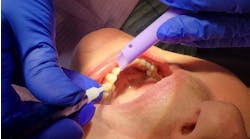North Carolina dentists are asking the public to pay more attention to the "cancer no one sees" -- oral pharyngeal cancer that can affect the oral cavity, lips, pharynx or tongue.
"Oral cancer kills one American every hour. That's more than melanoma or cervical cancer," said Dr. Andy Brown, a Cary dentist and president of the North Carolina Dental Society. "The irony is that this type of cancer is easy to detect and to prevent."
Brown said that, like most cancers, early detection and risk-factor prevention are the two best public health tools to reduce the mortality and morbidity of oral cancer.
"As many people as possible should have an annual oral cancer screening, especially those at greater risk," Brown advises, adding that the exam is simple and takes just a few moments in a dentist's office.
Risk factors include being male and over 40, having a past cancer history, compromised immune system, using tobacco or alcohol, and chronic exposure to sunlight. "People forget that extended exposure to the sun could be a factor in lip cancer," Brown said.
According to the National Institute of Health, the five-year survival rate for oral cancer is 52% and has remained at that point for five years. Oral pharyngeal cancer constitutes 2-4% of all cancers, translating to 30,000 (20,000 are men) new cases and 8,000 deaths annually in the United States.
"The use of tobacco, especially cigarettes, is the greatest risk factor, accounting for 80-90% of all oral cancers," Brown said, adding that the risk increases when these products are combined with alcohol use.
The American Dental Association (ADA) will launch a national oral cancer public awareness campaign in September and October. The campaign, which uses outdoor advertising in major U.S. cities, will emphasize the importance of early detection of oral cancer.
The ADA advises people to pay close attention to the appearance of their mouth and to contact their dentist if any of the following should occur:
A persistent sore or irritation that does not heal.
Color changes, such as development of red and/or white lesions.
Pain, tenderness or numbness anywhere in the mouth or lips.
A lump, thickening, rough spot, crust or small eroded area.
Difficulty in chewing, swallowing, speaking, or moving the jaw or tongue.
Additional information is available from dentists or by visiting the ADA Web site at www.ada.org.





